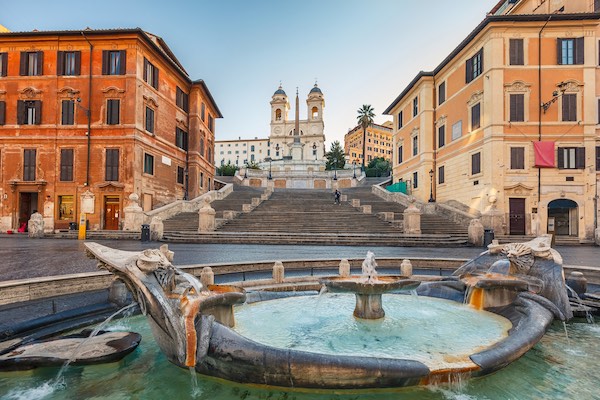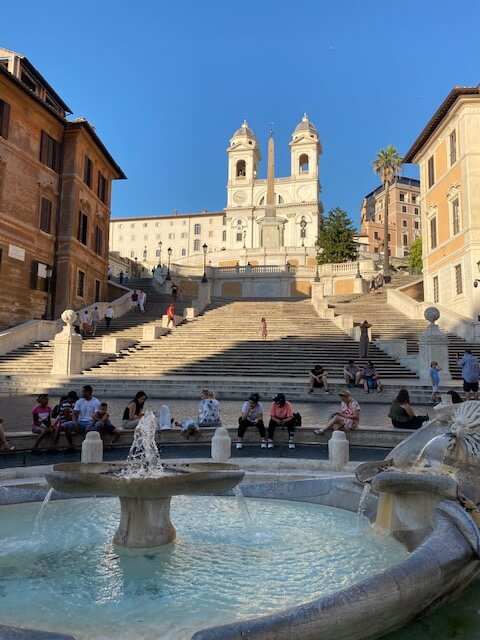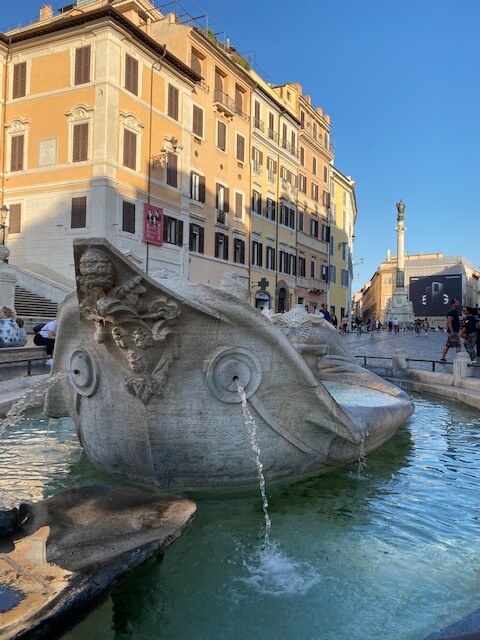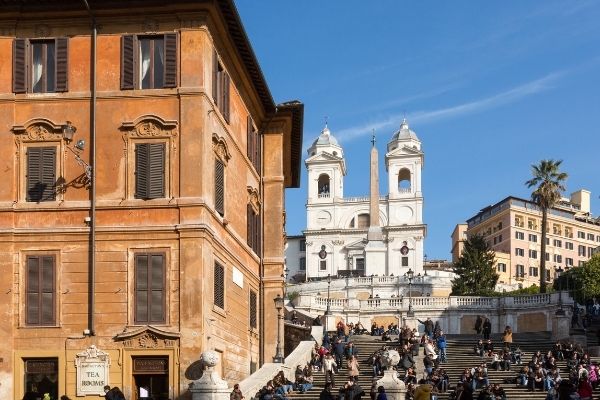All you need to know about the Spanish Steps in Rome. Fun facts, tips for visiting, best tours and hotels in the area.
The Spanish Steps are one of the most famous monuments in Rome.
They tower above the square by the same name, Piazza di Spagna (the Spanish Steps in Italian are called ‘Scalinata di Piazza di Spagna’) and they never fail to impress.
Large, beautiful and iconic, the Spanish steps elicit in first-time visitors the same marvel and wide-eyed reaction Audry Hepburn masterfully portrayed in the movie ‘A Roman Holiday’ and are a Rome must-see no Rome itinerary can leave out.
These are my tips tips for visiting the Spanish steps and some interesting and fun facts about them.
Please note: this post contains affiliate links and, should you make a purchase through them, we might make a small commission.

Facts about the Spanish Steps: chart
| Name | Spanish Steps / Scalinata di Trinita’ dei Monti / Scalinata di Piazza di Spagna |
| Date of construction | 1725 |
| Architect | Francesco de Sanctis |
| Number of Steps | 135 |
| Opening Hours | 24/7 |
| Admission ticket | N/A |
| Buses / Metro | Metro Stop: Spagna |
Why visit
The Spanish Steps are one of the most iconic sights in Rome. They are worth visiting because:
They are a quintessential Rome sight and one of the symbols of the city
The Steps are a wonderful example of urban architecture, unique in Rome
The Spanish Steps house one of Rome’s original Egyptian obelisks
The view from the top of the steps is breathtaking
The Spanish Steps are free and one of the most striking free attractions in Rome
The best way to visit the Spanish Steps
The best way to visit the Spanish Steps in foot. The best time to visit the Spanish Steps is early morning or at sunset (although sunset can be a busy time).
What are the Spanish Steps + location and how to get there
The Spanish Steps are a monumental stairway located in Piazza di Spagna, in Rome city center (the name of the neighborhood is Rione Colonna).
The closest metro station is “Spagna” which leaves you right beside the steps and several bus routes serve the area.
The closest bus stops to the Spanish steps are:
- Metro A Spagna,
- Bus 61, 63, 80, 85, 170, 590, 913, H
The whole area is closed to occasional traffic but does have residents’ cars, taxi and vehicles with special permits.
The best way to visit is on foot.
How to visit the Spanish steps: hours and cost
The Spanish steps are a passageway between Piazza di Spagna and the church of Trinita’ de’ Monti and are free to visit.
Access is possible day and night and no tickets are necessary. The steps are beautiful to see and they are also a beautiful panoramic point to get good views over Rome.
Fun fact: in the movie A Roman Holiday, Audrey Hepburn and Gregory Peck savor a gelato on the steps. While this was possible at the time, recently new regulations made sitting and eating on the Spanish steps illegal! Abide by the rule as fines are steep and the steps are precious.
The best time to visit the Spanish Steps
The steps can be visited any time of the day and night however, some times are better than others.
The early evening, just before sunset, is a lovely time to visit and catch a view, while at night, when the lights are on, is my favorite time to visit the stairs themselves and leisurely take in their elaborate beauty.
The worst time to visit the Spanish steps is usually lunchtime and the early afternoon, when visitors and street sellers tend to abound, making the whole area less relaxing if not downright annoying.

Fun and interesting facts about Scalinata di Spagna
The Spanish steps were built 1723-1725 by architect Francesco de Sanctis who received the commission for the building work by Pope Clemens XI Albani.
While the project didn’t see the light until the early XVIII century, this was not the first time the idea of creating a stairwell between Trinita’ dei Monti and Piazza di Spagna was discussed.
Documents tell us that the idea was already explored in the mid-1500s and that around 1570, Pope Gregorio XIII bought the land, with the aim of building as staircase ‘similar to that of Ara Coeli’ on the Capitoline Hill.
In the 1600s, a generous inheritance from Stefano Gueffier gave new impetus to the idea and several projects were proposed, including one by Bernini.
Sources report that it belongs to Gian Lorenzo Bernini the idea of giving the steps the curves lines we still see today.
However, disputes between the French and the Vatican over ownership of the land delayed the building work.
It is only in 1717 that Pope Clemens XI was able to call for design submissions and works started under his successor Innocent XIII Conti.
It is only in 1726 that the project came to an end: Pope Benedict XIII inaugurated the Steps in 1726.
The architect responsible for the construction of the Spanish Steps is Francesco de Sanctis.
The Spanish steps in Rome count 136 steps.
The long history of the Spanish Steps gave the staircase some interesting elements worth seeing such as the French Lilies and the family crest of the Conti family, Pope Clement XI belonged to.
What to see nearby
The Spanish steps dominate Piazza di Spagna however, they are not the only thing to see here. In Piazza di Spagna it is also worth seeing:
Trinita’ dei Monti church
The church of the Santissima Trinità dei Monti, towers above piazza di Spagna with two distinctive belltowers that give the square and the steps their iconic look.
The church dates back to the XVI century and sits on what used to be a vineyard.
The church is under the tutelage of the French Embassy to the Holy See and is worth a visit.
It has beautiful frescoes and chapel and a convent both, in normal times, open to visitors (please note this has changed in 2020, check the church website for details)
Obelisco Sallustiano (Sallustian’s Obelisk)
The steps are surmounted by an Egyptian obelisk, called Obelisco Sallustiano.
The obelisk is one of the 13 ancient obelisks in Rome and was built by the Romans following the Egyptian style so popular I the city and that also gave us the peculiar Rome Pyramid.

La fontana della barcaccia (Barcaccia fountain)
At the bottom of the Spanish steps lies one of the most famous fountains in Rome, called ‘la barcaccia’.
The fountain was built by Bernini (both father Pietro Bernini and son, the famous Gian Lorenzo Bernini) and represents a shipwreck, in remembrance of the time when the Tiber overflew and, it is said brought a destroyed vessel up to this very location.
The water comes from the ‘Acquedotto Vergine’ (Aqua Virgo), the same aqueduct that brings water to the Trevi Fountain and that dates back to ancient Roman times.
The fountain is low in height and, when the square gets busy, may not seem too impressive, however, it is worth seeing as the details are wonderful. The attentive eye will see the carving of bees, the symbol of the Barberini family who commissioned the build.

Babington Tea Room
Tea Rooms may not strike as the most roman of places.
However, Babington’s tea house is a bit of an institution in Rome.
It was established I 1893 by Isabel Cargill and Mria Babington and, since then, has served tea to refined clientele in the eternal city from its glorious locations on Piazza di Spagna.
Since then, is has stayed one of the best addresses for tea in Rome.

Keats – Shelley House
Walking up the steps, you will notice a small, pretty building overlooking the steps.
This house used to be a pension and room rental place that once hosted the poet John Keats, who spent here his last few days.
Nowadays it is a museum dedicated to English Romantics and still hosts the room where Keats died (if you love the poet, you may also want to go visit his grave in the stunning Protestant Cemetery of Rome).
Best hotels near the Spanish steps
The area around Piazza di Spagna and the steps is central and one of the best neighbourhoods to stay in Rome on a first visit.
It it, however, an elegant location, with high-end hotels, shops and restaurants so it is most suited to visitors with a generous budget.
Some of the best hotels near the Spanish Steps are (the links lead you to booking.com, a platform I trust and that tend to offer the best cancellation options even at short notice)
Hassler Hotel Roma (luxury)
Hotel Scalinata di Spagna (3-star hotel at the top of the steps)
Internazionale Domus (3-star hotel on Piazza di Spagna)
Crossing Condotti (4-star hotel close to the steps and in the heart of Rome’s most elegant shopping district)
The Inn at the Spanish Steps (4-star hotel with panoramic views of the Spanish Steps from the terrace)
Roccoforte Hotel De Russie (luxury)
Piazza di Spagna 9 (boutique hotel)
Rome walking tours that include the Spanish Steps
Many Rome walking tours include this area. Some worth checking out are:
- Best of Rome squares and fountains walking tour
- Piazzas of Rome small group sunset walking tour
- Rome twilight walking and gelato tasting tour
Rome hop-on hop-off bus tours also bring you close to the Spanish Steps Please note that, in Rome city centre, you will do a lot of walking and comfortable shoes are a must.
You can find my recommended walking shoes for Rome here.
I hope you found this article interesting and useful. Love from Rome x
How to visit the Spanish Steps – pin this!

This post was first published in 2020 and has now been fully update with relevant info and rules for visiting.
